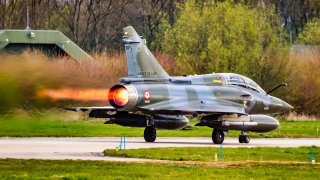Mirage 2000: France's Air Force Had One Fighter Plane No Nation Wanted to Battle
The Dassault Mirage 2000, a predecessor to the renowned Rafale, is a testament to France's pioneering work in delta-winged fighters, first taking to the skies in 1978.
Summary: The Dassault Mirage 2000, a predecessor to the renowned Rafale, is a testament to France's pioneering work in delta-winged fighters, first taking to the skies in 1978. As a replacement for the Mirage III, it emerged from a rapid development phase, showcasing its capabilities by breaking Mach 1 without afterburners on its maiden flight. Boasting a design optimized for both high-speed performance and low-speed maneuverability, the Mirage 2000 features a delta-wing construction that affords a large wing area, resulting in low wing loading and superior agility compared to contemporaries like the F-15 and F-16.
France Makes Aviation History
French aerospace manufacturer Dassault is perhaps best known for the delta-wing Rafale fighter. But the Rafale was not Dassault’s first delta-winged fighter. Flying first in 1978 was the Mirage 2000, which would be produced for 30 years and flown by air forces around the world.
Introducing the Mirage 2000
The Mirage 2000 was designed as a lightweight fighter replacement for the Mirage III, which the French Air Force used in the 1960s and 1970s. (The Mirage III is still in use today with the Pakistani Air Force.) Production of the Mirage 2000 occurred at three different sites. The wings were built at Martignas, while the fuselages were built at Argenteuil. Final assembly was overseen at the Bordeaux-Merignac Airport.
The Mirage 2000’s debut flight in 1978 took place just 27 months after the program was given a green light. Piloting the first flight was Jean Coureau, who took the jet to Mach 1.02 without afterburner, climbed to 12,000 meters, and then accelerated to Mach 1.3. After 65 minutes aloft, Coureau returned the aircraft safely to Earth.
Later, the Mirage 2000 would show itself capable of surpassing Mach 2 while still retaining the ability to perform well at low speed. The jet could maintain a 25-degree angle of attack, or 30 degrees with fuel and ordnance.
Designing the Mirage 2000
When the Mirage 2000 rolled off the assembly line, it featured a delta-wing construction. Specifically, the jet had low-set, thin wings with a leading edge swept back at 58 degrees and a trailing-edge forward sweep of 3.5 degrees. The wing’s flight surfaces were composed of four elevons and four leading edge slats.
One benefit of the delta-wing design was a comparatively large wing area, which reduced wing loading. The Mirage 2000’s wing area was about 41 meters squared, creating a wing loading of about 77 pounds per square foot at a takeoff weight of 33,000 pounds. The result was a highly maneuverable aircraft, exceeding the maneuverability of the F-15 and the similarly sized F-16, which had a wing loading of 110 pounds per square foot.
Another benefit of the Mirage 2000’s delta wing was the blending of wing root and engine, which allowed the jet to carry more fuel. The jet’s internal fuel tanks could carry over 900 gallons of fuel – about 200 gallons more than the Mirage III.
The delta wing also allowed for low drag, low radar cross section, high-speed aerodynamics, and a simple design.
An airbrake was fitted above and below each of the wings, while a distinctly tall tailfin helped increase stability. The jet was designed with a degree of relaxed stability, with the center of gravity placed ahead of the center of pressure. This, again, enhanced maneuverability. The Mirage 2000 relied on fly-by-wire controls and four analog computers to help maintain stable flight – a necessity given the shortcomings of the delta wing at low speed.
The Mirage 2000 ran on an SNECMA M53 afterburning turbofan engine, a single-shaft engine of modular construction that was relatively light and simple. The M53 featured three low-pressure compressor stages, five high-pressure stages, and two turbine stages. The engine was rated for 21,000 pounds of thrust with afterburners engaged.
The jet was equipped with two built-in DEGA 554 autocannons, a 30mm revolver-type cannon with 125 rounds each. The cannons could be configured to fire at either 1,200 or 1,800 rounds per minute.
Entering service
The Mirage 2000 entered service with the French Air Force in 1984. The jet was deployed during the Gulf War, flying high-altitude air defense for U.S. Air Force U-2 spy planes. The Mirage 2000 would later support NATO forces during the Bosnian War and Kosovo War. One Mirage 2000 was shot down over Bosnia; the pilots were captured and later released after mediation.
The French found an eager export market for the Mirage 2000. The jet was exported to India, the United Arab Emirates, Taiwan, Greece, Egypt, Brazil, Qatar, and Peru.
In all, the Mirage 2000 was a relatively cheap and small fighter with respectable performance. Granted, peer aircraft overshadowed the Mirage 2000, and it has come to be associated with developing-world air forces.
About the Author: Harrison Kass
Harrison Kass is a defense and national security writer with over 1,000 total pieces on issues involving global affairs. An attorney, pilot, guitarist, and minor pro hockey player, Harrison joined the US Air Force as a Pilot Trainee but was medically discharged. Harrison holds a BA from Lake Forest College, a JD from the University of Oregon, and an MA from New York University. Harrison listens to Dokken.
Image Credit: Creative Commons.


